ATHE Level 7: Leadership, Strategy & Personal Development Plan
VerifiedAdded on 2023/06/11
|28
|7692
|257
Report
AI Summary
This report provides an analysis of personal development for leadership and strategic management within an organizational context. It explores the knowledge and skills essential for creating and achieving an organization's vision and strategy, emphasizing factors beyond mere skills and knowledge that contribute to this achievement. The report reviews various leadership and management theories, assesses their implications for personal development, and includes a personal leadership and management skills audit. Objectives are set to meet personal development needs, culminating in a personal development plan designed to enhance leadership and management skills. The document also discusses the benefits of personal development in achieving both personal growth and organizational objectives, evaluating information sources for reviewing progress against personal development plans. This comprehensive analysis aims to provide a structured approach to personal development in leadership and strategic management, aligning individual growth with organizational vision and strategy.

ATHE Level 7 - Personal Development for
Leadership
Extended Diploma in Strategic Management
Leadership
Extended Diploma in Strategic Management
Paraphrase This Document
Need a fresh take? Get an instant paraphrase of this document with our AI Paraphraser
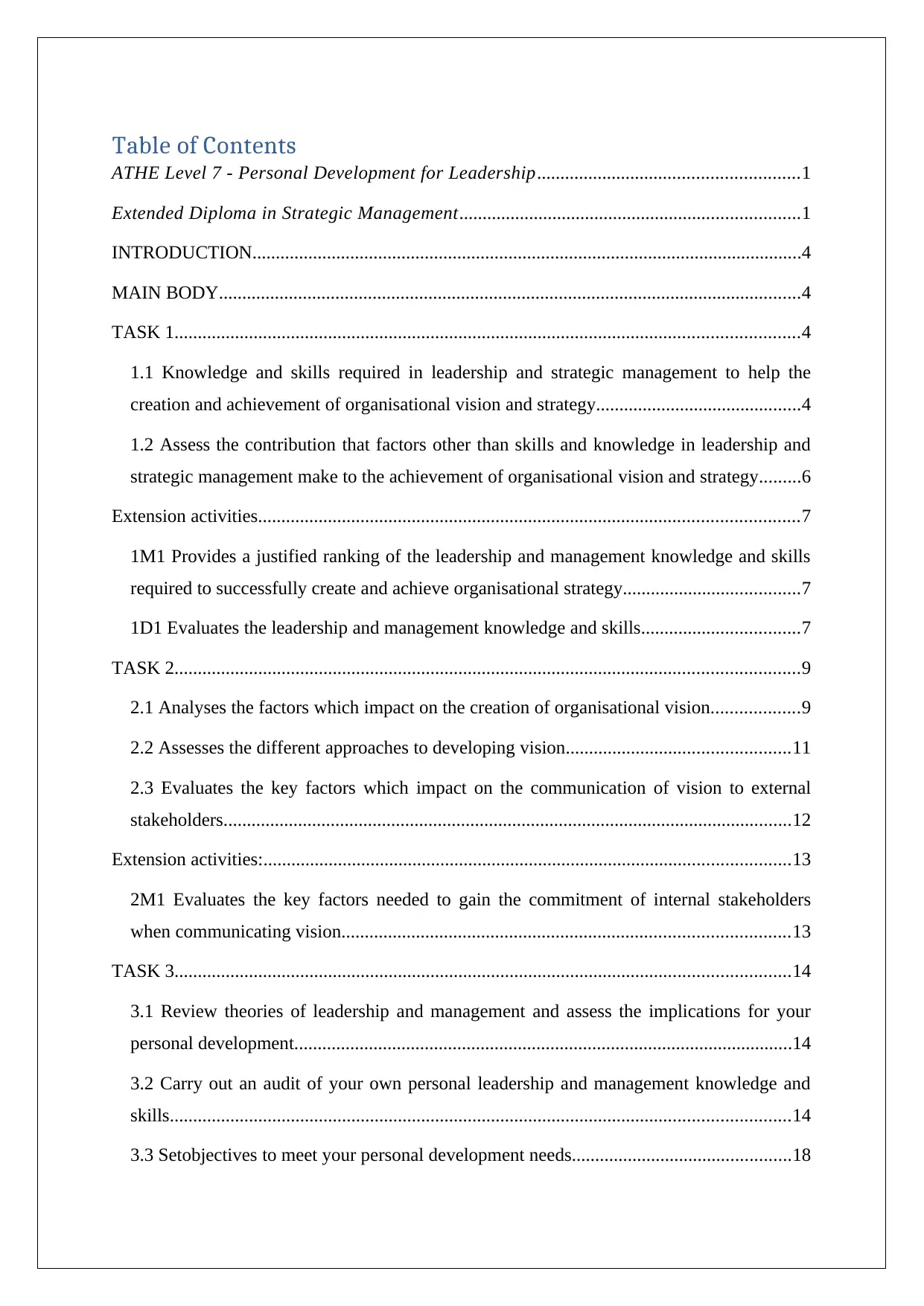
Table of Contents
ATHE Level 7 - Personal Development for Leadership........................................................1
Extended Diploma in Strategic Management.........................................................................1
INTRODUCTION......................................................................................................................4
MAIN BODY.............................................................................................................................4
TASK 1......................................................................................................................................4
1.1 Knowledge and skills required in leadership and strategic management to help the
creation and achievement of organisational vision and strategy............................................4
1.2 Assess the contribution that factors other than skills and knowledge in leadership and
strategic management make to the achievement of organisational vision and strategy.........6
Extension activities....................................................................................................................7
1M1 Provides a justified ranking of the leadership and management knowledge and skills
required to successfully create and achieve organisational strategy......................................7
1D1 Evaluates the leadership and management knowledge and skills..................................7
TASK 2......................................................................................................................................9
2.1 Analyses the factors which impact on the creation of organisational vision...................9
2.2 Assesses the different approaches to developing vision................................................11
2.3 Evaluates the key factors which impact on the communication of vision to external
stakeholders..........................................................................................................................12
Extension activities:.................................................................................................................13
2M1 Evaluates the key factors needed to gain the commitment of internal stakeholders
when communicating vision................................................................................................13
TASK 3....................................................................................................................................14
3.1 Review theories of leadership and management and assess the implications for your
personal development...........................................................................................................14
3.2 Carry out an audit of your own personal leadership and management knowledge and
skills.....................................................................................................................................14
3.3 Setobjectives to meet your personal development needs...............................................18
ATHE Level 7 - Personal Development for Leadership........................................................1
Extended Diploma in Strategic Management.........................................................................1
INTRODUCTION......................................................................................................................4
MAIN BODY.............................................................................................................................4
TASK 1......................................................................................................................................4
1.1 Knowledge and skills required in leadership and strategic management to help the
creation and achievement of organisational vision and strategy............................................4
1.2 Assess the contribution that factors other than skills and knowledge in leadership and
strategic management make to the achievement of organisational vision and strategy.........6
Extension activities....................................................................................................................7
1M1 Provides a justified ranking of the leadership and management knowledge and skills
required to successfully create and achieve organisational strategy......................................7
1D1 Evaluates the leadership and management knowledge and skills..................................7
TASK 2......................................................................................................................................9
2.1 Analyses the factors which impact on the creation of organisational vision...................9
2.2 Assesses the different approaches to developing vision................................................11
2.3 Evaluates the key factors which impact on the communication of vision to external
stakeholders..........................................................................................................................12
Extension activities:.................................................................................................................13
2M1 Evaluates the key factors needed to gain the commitment of internal stakeholders
when communicating vision................................................................................................13
TASK 3....................................................................................................................................14
3.1 Review theories of leadership and management and assess the implications for your
personal development...........................................................................................................14
3.2 Carry out an audit of your own personal leadership and management knowledge and
skills.....................................................................................................................................14
3.3 Setobjectives to meet your personal development needs...............................................18
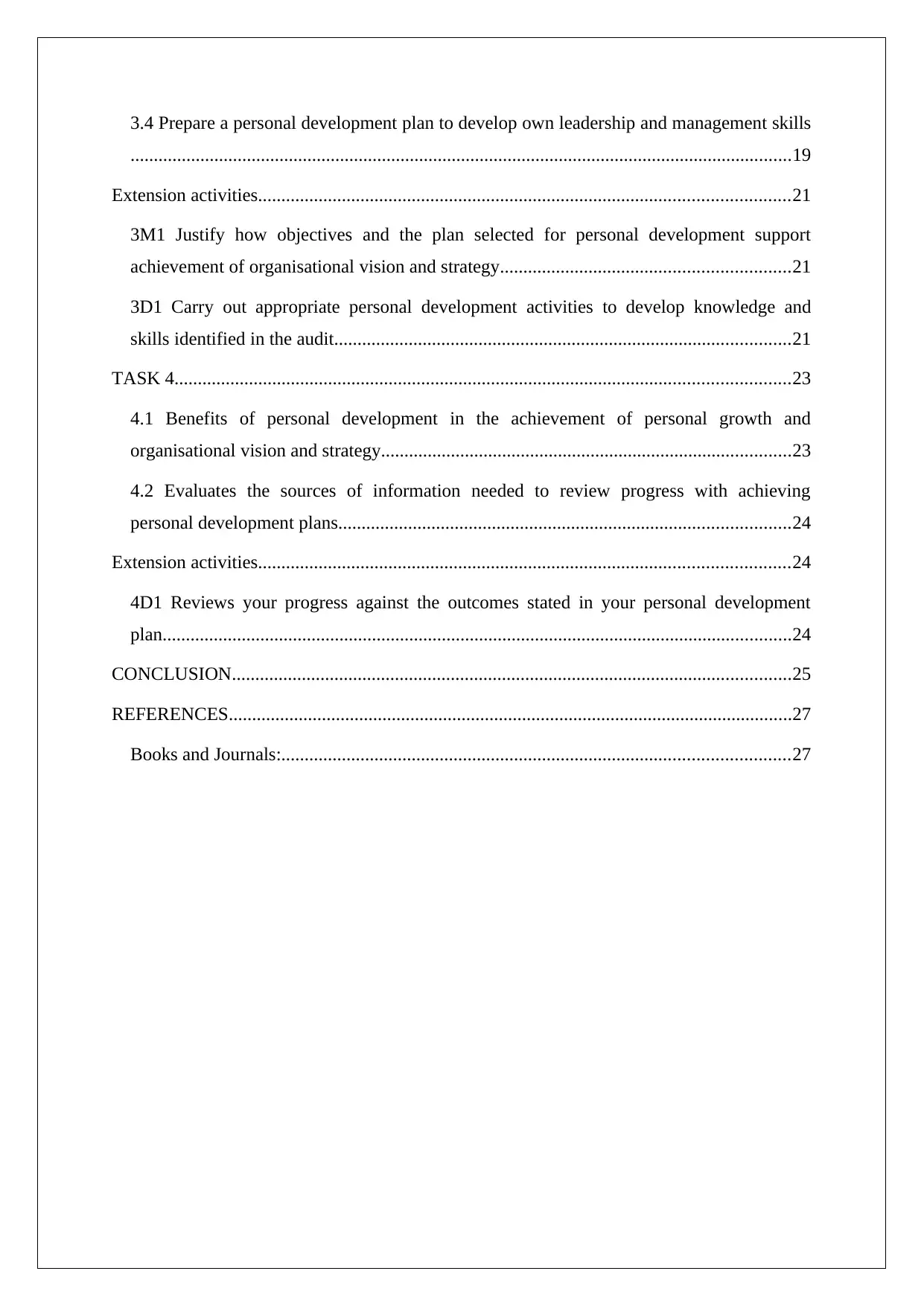
3.4 Prepare a personal development plan to develop own leadership and management skills
..............................................................................................................................................19
Extension activities..................................................................................................................21
3M1 Justify how objectives and the plan selected for personal development support
achievement of organisational vision and strategy..............................................................21
3D1 Carry out appropriate personal development activities to develop knowledge and
skills identified in the audit..................................................................................................21
TASK 4....................................................................................................................................23
4.1 Benefits of personal development in the achievement of personal growth and
organisational vision and strategy........................................................................................23
4.2 Evaluates the sources of information needed to review progress with achieving
personal development plans.................................................................................................24
Extension activities..................................................................................................................24
4D1 Reviews your progress against the outcomes stated in your personal development
plan.......................................................................................................................................24
CONCLUSION........................................................................................................................25
REFERENCES.........................................................................................................................27
Books and Journals:.............................................................................................................27
..............................................................................................................................................19
Extension activities..................................................................................................................21
3M1 Justify how objectives and the plan selected for personal development support
achievement of organisational vision and strategy..............................................................21
3D1 Carry out appropriate personal development activities to develop knowledge and
skills identified in the audit..................................................................................................21
TASK 4....................................................................................................................................23
4.1 Benefits of personal development in the achievement of personal growth and
organisational vision and strategy........................................................................................23
4.2 Evaluates the sources of information needed to review progress with achieving
personal development plans.................................................................................................24
Extension activities..................................................................................................................24
4D1 Reviews your progress against the outcomes stated in your personal development
plan.......................................................................................................................................24
CONCLUSION........................................................................................................................25
REFERENCES.........................................................................................................................27
Books and Journals:.............................................................................................................27
⊘ This is a preview!⊘
Do you want full access?
Subscribe today to unlock all pages.

Trusted by 1+ million students worldwide
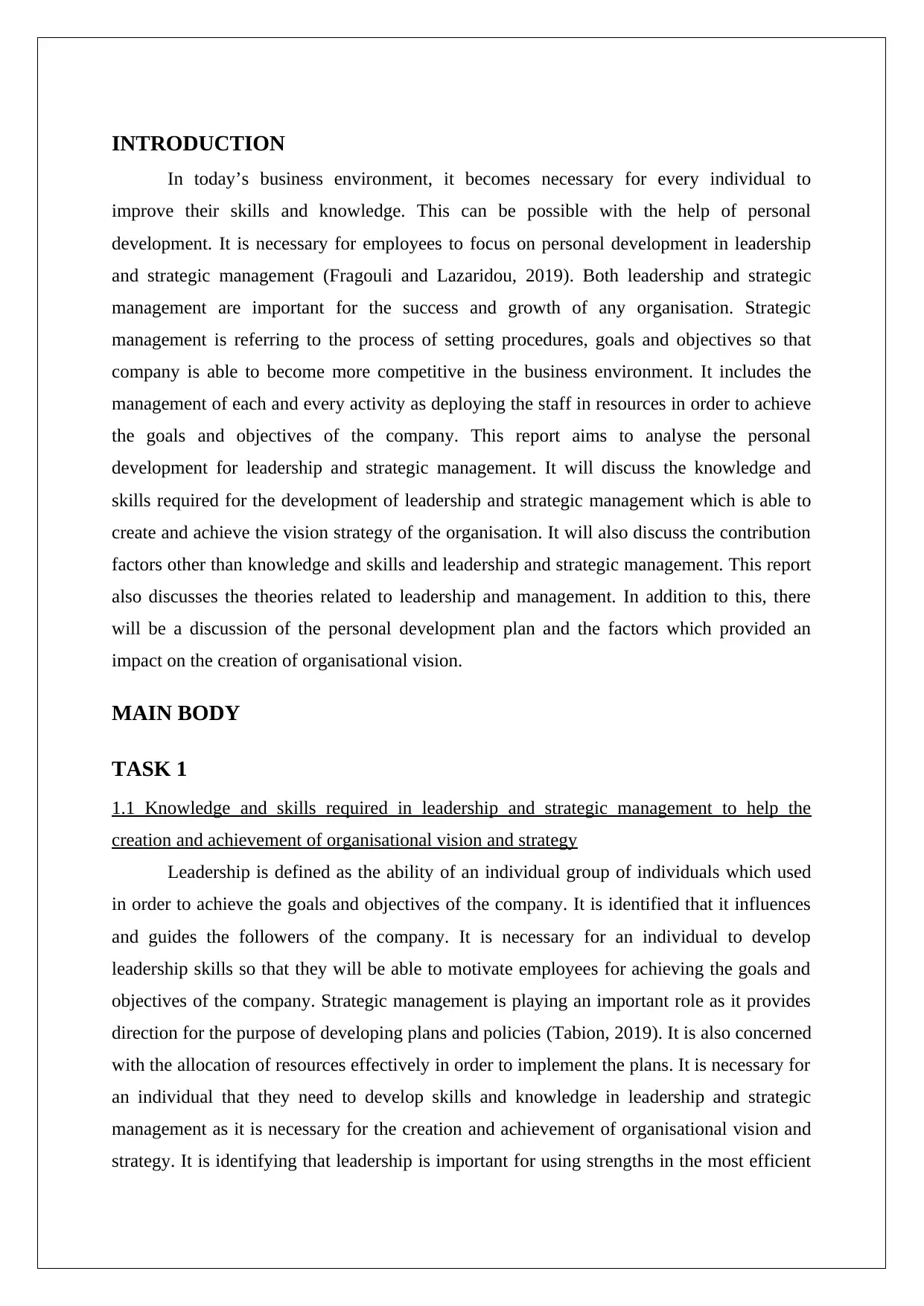
INTRODUCTION
In today’s business environment, it becomes necessary for every individual to
improve their skills and knowledge. This can be possible with the help of personal
development. It is necessary for employees to focus on personal development in leadership
and strategic management (Fragouli and Lazaridou, 2019). Both leadership and strategic
management are important for the success and growth of any organisation. Strategic
management is referring to the process of setting procedures, goals and objectives so that
company is able to become more competitive in the business environment. It includes the
management of each and every activity as deploying the staff in resources in order to achieve
the goals and objectives of the company. This report aims to analyse the personal
development for leadership and strategic management. It will discuss the knowledge and
skills required for the development of leadership and strategic management which is able to
create and achieve the vision strategy of the organisation. It will also discuss the contribution
factors other than knowledge and skills and leadership and strategic management. This report
also discusses the theories related to leadership and management. In addition to this, there
will be a discussion of the personal development plan and the factors which provided an
impact on the creation of organisational vision.
MAIN BODY
TASK 1
1.1 Knowledge and skills required in leadership and strategic management to help the
creation and achievement of organisational vision and strategy
Leadership is defined as the ability of an individual group of individuals which used
in order to achieve the goals and objectives of the company. It is identified that it influences
and guides the followers of the company. It is necessary for an individual to develop
leadership skills so that they will be able to motivate employees for achieving the goals and
objectives of the company. Strategic management is playing an important role as it provides
direction for the purpose of developing plans and policies (Tabion, 2019). It is also concerned
with the allocation of resources effectively in order to implement the plans. It is necessary for
an individual that they need to develop skills and knowledge in leadership and strategic
management as it is necessary for the creation and achievement of organisational vision and
strategy. It is identifying that leadership is important for using strengths in the most efficient
In today’s business environment, it becomes necessary for every individual to
improve their skills and knowledge. This can be possible with the help of personal
development. It is necessary for employees to focus on personal development in leadership
and strategic management (Fragouli and Lazaridou, 2019). Both leadership and strategic
management are important for the success and growth of any organisation. Strategic
management is referring to the process of setting procedures, goals and objectives so that
company is able to become more competitive in the business environment. It includes the
management of each and every activity as deploying the staff in resources in order to achieve
the goals and objectives of the company. This report aims to analyse the personal
development for leadership and strategic management. It will discuss the knowledge and
skills required for the development of leadership and strategic management which is able to
create and achieve the vision strategy of the organisation. It will also discuss the contribution
factors other than knowledge and skills and leadership and strategic management. This report
also discusses the theories related to leadership and management. In addition to this, there
will be a discussion of the personal development plan and the factors which provided an
impact on the creation of organisational vision.
MAIN BODY
TASK 1
1.1 Knowledge and skills required in leadership and strategic management to help the
creation and achievement of organisational vision and strategy
Leadership is defined as the ability of an individual group of individuals which used
in order to achieve the goals and objectives of the company. It is identified that it influences
and guides the followers of the company. It is necessary for an individual to develop
leadership skills so that they will be able to motivate employees for achieving the goals and
objectives of the company. Strategic management is playing an important role as it provides
direction for the purpose of developing plans and policies (Tabion, 2019). It is also concerned
with the allocation of resources effectively in order to implement the plans. It is necessary for
an individual that they need to develop skills and knowledge in leadership and strategic
management as it is necessary for the creation and achievement of organisational vision and
strategy. It is identifying that leadership is important for using strengths in the most efficient
Paraphrase This Document
Need a fresh take? Get an instant paraphrase of this document with our AI Paraphraser
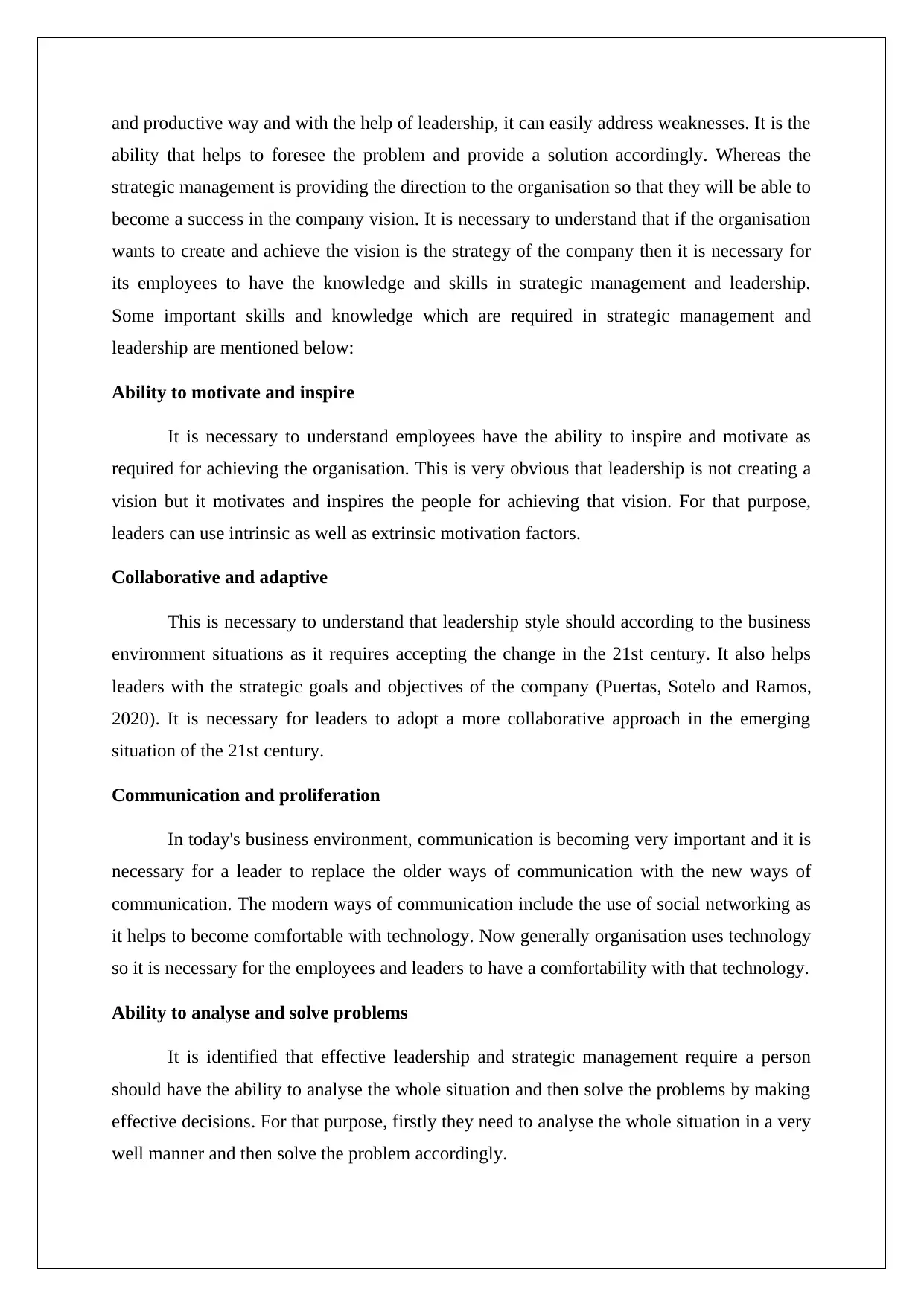
and productive way and with the help of leadership, it can easily address weaknesses. It is the
ability that helps to foresee the problem and provide a solution accordingly. Whereas the
strategic management is providing the direction to the organisation so that they will be able to
become a success in the company vision. It is necessary to understand that if the organisation
wants to create and achieve the vision is the strategy of the company then it is necessary for
its employees to have the knowledge and skills in strategic management and leadership.
Some important skills and knowledge which are required in strategic management and
leadership are mentioned below:
Ability to motivate and inspire
It is necessary to understand employees have the ability to inspire and motivate as
required for achieving the organisation. This is very obvious that leadership is not creating a
vision but it motivates and inspires the people for achieving that vision. For that purpose,
leaders can use intrinsic as well as extrinsic motivation factors.
Collaborative and adaptive
This is necessary to understand that leadership style should according to the business
environment situations as it requires accepting the change in the 21st century. It also helps
leaders with the strategic goals and objectives of the company (Puertas, Sotelo and Ramos,
2020). It is necessary for leaders to adopt a more collaborative approach in the emerging
situation of the 21st century.
Communication and proliferation
In today's business environment, communication is becoming very important and it is
necessary for a leader to replace the older ways of communication with the new ways of
communication. The modern ways of communication include the use of social networking as
it helps to become comfortable with technology. Now generally organisation uses technology
so it is necessary for the employees and leaders to have a comfortability with that technology.
Ability to analyse and solve problems
It is identified that effective leadership and strategic management require a person
should have the ability to analyse the whole situation and then solve the problems by making
effective decisions. For that purpose, firstly they need to analyse the whole situation in a very
well manner and then solve the problem accordingly.
ability that helps to foresee the problem and provide a solution accordingly. Whereas the
strategic management is providing the direction to the organisation so that they will be able to
become a success in the company vision. It is necessary to understand that if the organisation
wants to create and achieve the vision is the strategy of the company then it is necessary for
its employees to have the knowledge and skills in strategic management and leadership.
Some important skills and knowledge which are required in strategic management and
leadership are mentioned below:
Ability to motivate and inspire
It is necessary to understand employees have the ability to inspire and motivate as
required for achieving the organisation. This is very obvious that leadership is not creating a
vision but it motivates and inspires the people for achieving that vision. For that purpose,
leaders can use intrinsic as well as extrinsic motivation factors.
Collaborative and adaptive
This is necessary to understand that leadership style should according to the business
environment situations as it requires accepting the change in the 21st century. It also helps
leaders with the strategic goals and objectives of the company (Puertas, Sotelo and Ramos,
2020). It is necessary for leaders to adopt a more collaborative approach in the emerging
situation of the 21st century.
Communication and proliferation
In today's business environment, communication is becoming very important and it is
necessary for a leader to replace the older ways of communication with the new ways of
communication. The modern ways of communication include the use of social networking as
it helps to become comfortable with technology. Now generally organisation uses technology
so it is necessary for the employees and leaders to have a comfortability with that technology.
Ability to analyse and solve problems
It is identified that effective leadership and strategic management require a person
should have the ability to analyse the whole situation and then solve the problems by making
effective decisions. For that purpose, firstly they need to analyse the whole situation in a very
well manner and then solve the problem accordingly.
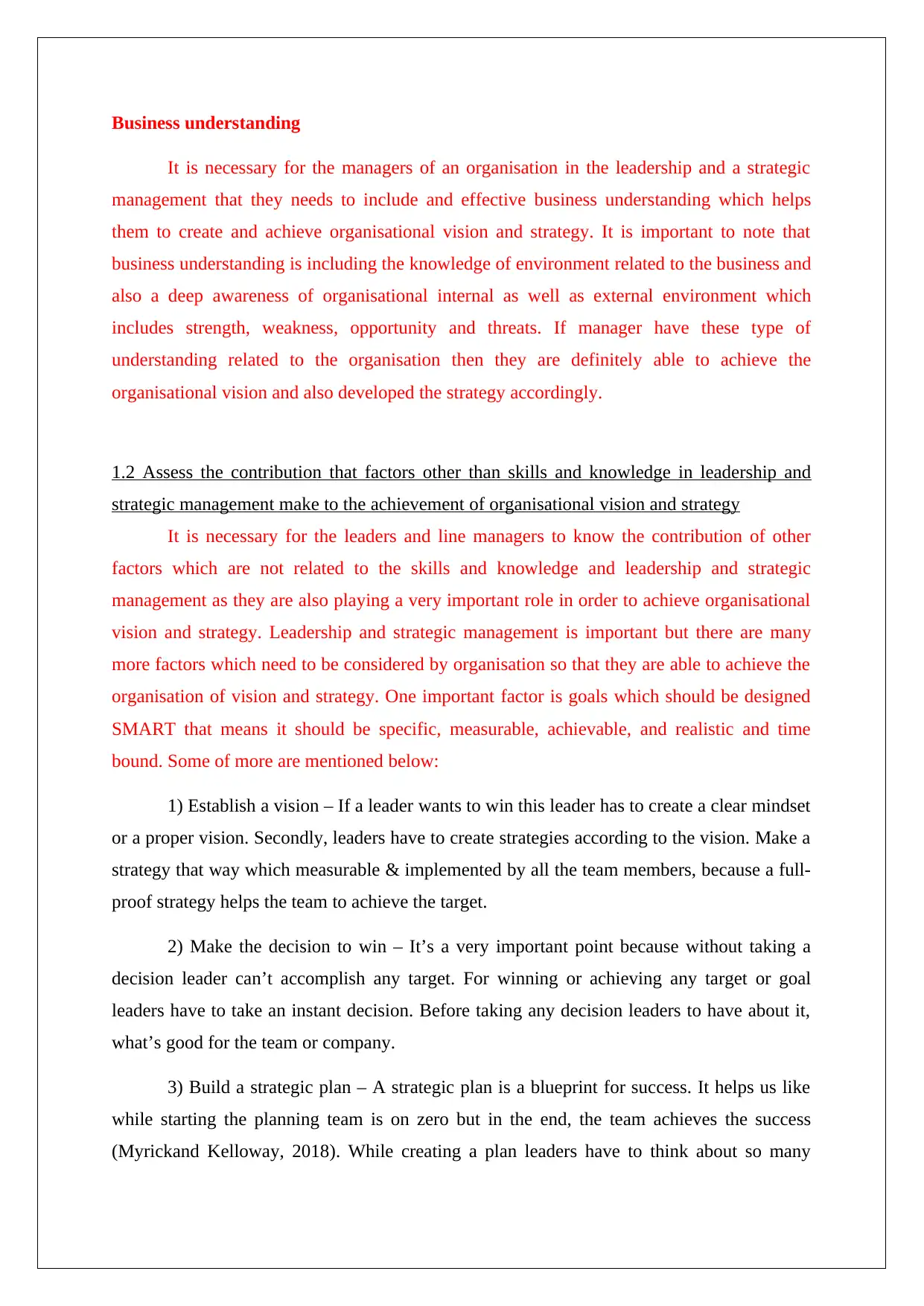
Business understanding
It is necessary for the managers of an organisation in the leadership and a strategic
management that they needs to include and effective business understanding which helps
them to create and achieve organisational vision and strategy. It is important to note that
business understanding is including the knowledge of environment related to the business and
also a deep awareness of organisational internal as well as external environment which
includes strength, weakness, opportunity and threats. If manager have these type of
understanding related to the organisation then they are definitely able to achieve the
organisational vision and also developed the strategy accordingly.
1.2 Assess the contribution that factors other than skills and knowledge in leadership and
strategic management make to the achievement of organisational vision and strategy
It is necessary for the leaders and line managers to know the contribution of other
factors which are not related to the skills and knowledge and leadership and strategic
management as they are also playing a very important role in order to achieve organisational
vision and strategy. Leadership and strategic management is important but there are many
more factors which need to be considered by organisation so that they are able to achieve the
organisation of vision and strategy. One important factor is goals which should be designed
SMART that means it should be specific, measurable, achievable, and realistic and time
bound. Some of more are mentioned below:
1) Establish a vision – If a leader wants to win this leader has to create a clear mindset
or a proper vision. Secondly, leaders have to create strategies according to the vision. Make a
strategy that way which measurable & implemented by all the team members, because a full-
proof strategy helps the team to achieve the target.
2) Make the decision to win – It’s a very important point because without taking a
decision leader can’t accomplish any target. For winning or achieving any target or goal
leaders have to take an instant decision. Before taking any decision leaders to have about it,
what’s good for the team or company.
3) Build a strategic plan – A strategic plan is a blueprint for success. It helps us like
while starting the planning team is on zero but in the end, the team achieves the success
(Myrickand Kelloway, 2018). While creating a plan leaders have to think about so many
It is necessary for the managers of an organisation in the leadership and a strategic
management that they needs to include and effective business understanding which helps
them to create and achieve organisational vision and strategy. It is important to note that
business understanding is including the knowledge of environment related to the business and
also a deep awareness of organisational internal as well as external environment which
includes strength, weakness, opportunity and threats. If manager have these type of
understanding related to the organisation then they are definitely able to achieve the
organisational vision and also developed the strategy accordingly.
1.2 Assess the contribution that factors other than skills and knowledge in leadership and
strategic management make to the achievement of organisational vision and strategy
It is necessary for the leaders and line managers to know the contribution of other
factors which are not related to the skills and knowledge and leadership and strategic
management as they are also playing a very important role in order to achieve organisational
vision and strategy. Leadership and strategic management is important but there are many
more factors which need to be considered by organisation so that they are able to achieve the
organisation of vision and strategy. One important factor is goals which should be designed
SMART that means it should be specific, measurable, achievable, and realistic and time
bound. Some of more are mentioned below:
1) Establish a vision – If a leader wants to win this leader has to create a clear mindset
or a proper vision. Secondly, leaders have to create strategies according to the vision. Make a
strategy that way which measurable & implemented by all the team members, because a full-
proof strategy helps the team to achieve the target.
2) Make the decision to win – It’s a very important point because without taking a
decision leader can’t accomplish any target. For winning or achieving any target or goal
leaders have to take an instant decision. Before taking any decision leaders to have about it,
what’s good for the team or company.
3) Build a strategic plan – A strategic plan is a blueprint for success. It helps us like
while starting the planning team is on zero but in the end, the team achieves the success
(Myrickand Kelloway, 2018). While creating a plan leaders have to think about so many
⊘ This is a preview!⊘
Do you want full access?
Subscribe today to unlock all pages.

Trusted by 1+ million students worldwide
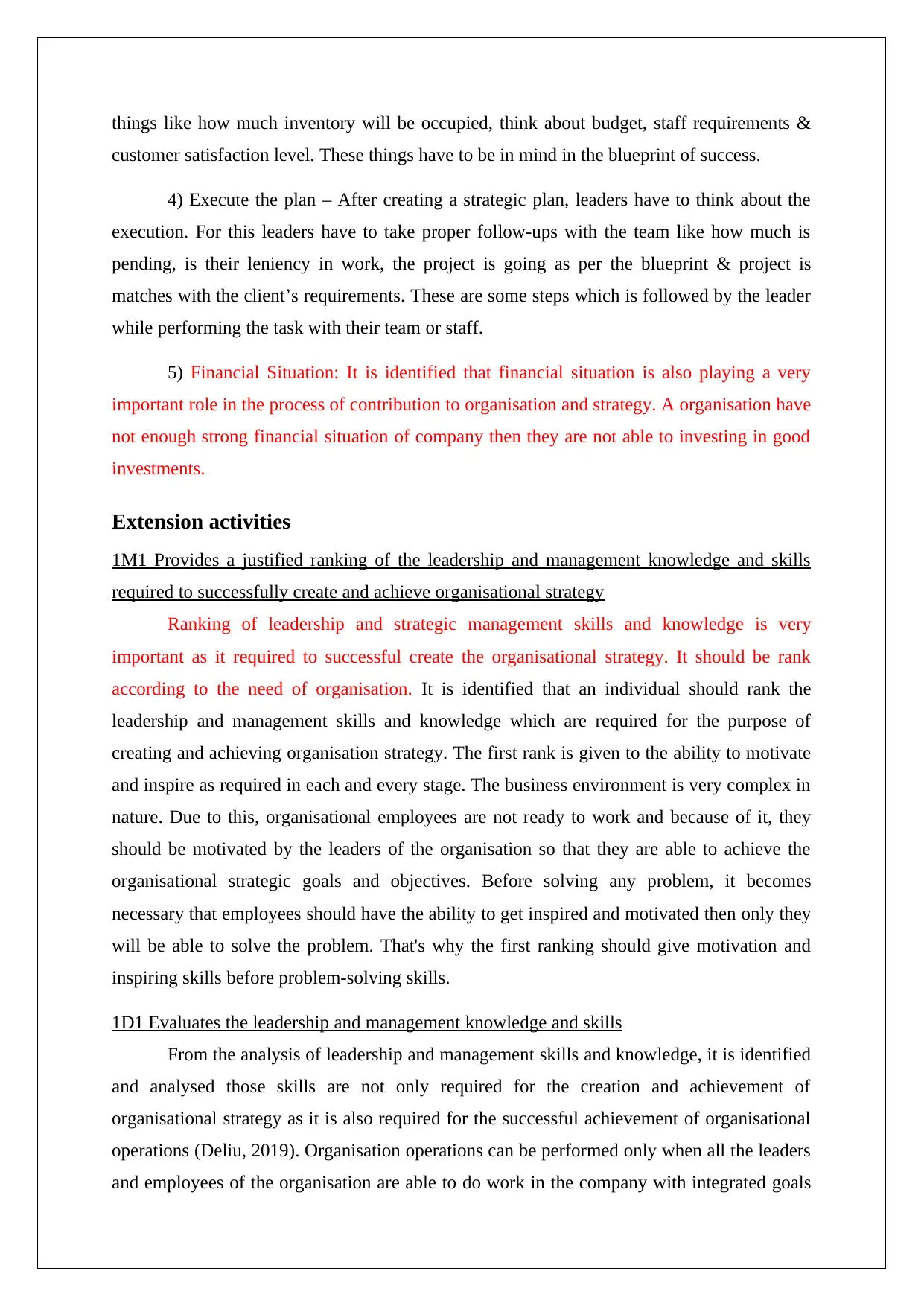
things like how much inventory will be occupied, think about budget, staff requirements &
customer satisfaction level. These things have to be in mind in the blueprint of success.
4) Execute the plan – After creating a strategic plan, leaders have to think about the
execution. For this leaders have to take proper follow-ups with the team like how much is
pending, is their leniency in work, the project is going as per the blueprint & project is
matches with the client’s requirements. These are some steps which is followed by the leader
while performing the task with their team or staff.
5) Financial Situation: It is identified that financial situation is also playing a very
important role in the process of contribution to organisation and strategy. A organisation have
not enough strong financial situation of company then they are not able to investing in good
investments.
Extension activities
1M1 Provides a justified ranking of the leadership and management knowledge and skills
required to successfully create and achieve organisational strategy
Ranking of leadership and strategic management skills and knowledge is very
important as it required to successful create the organisational strategy. It should be rank
according to the need of organisation. It is identified that an individual should rank the
leadership and management skills and knowledge which are required for the purpose of
creating and achieving organisation strategy. The first rank is given to the ability to motivate
and inspire as required in each and every stage. The business environment is very complex in
nature. Due to this, organisational employees are not ready to work and because of it, they
should be motivated by the leaders of the organisation so that they are able to achieve the
organisational strategic goals and objectives. Before solving any problem, it becomes
necessary that employees should have the ability to get inspired and motivated then only they
will be able to solve the problem. That's why the first ranking should give motivation and
inspiring skills before problem-solving skills.
1D1 Evaluates the leadership and management knowledge and skills
From the analysis of leadership and management skills and knowledge, it is identified
and analysed those skills are not only required for the creation and achievement of
organisational strategy as it is also required for the successful achievement of organisational
operations (Deliu, 2019). Organisation operations can be performed only when all the leaders
and employees of the organisation are able to do work in the company with integrated goals
customer satisfaction level. These things have to be in mind in the blueprint of success.
4) Execute the plan – After creating a strategic plan, leaders have to think about the
execution. For this leaders have to take proper follow-ups with the team like how much is
pending, is their leniency in work, the project is going as per the blueprint & project is
matches with the client’s requirements. These are some steps which is followed by the leader
while performing the task with their team or staff.
5) Financial Situation: It is identified that financial situation is also playing a very
important role in the process of contribution to organisation and strategy. A organisation have
not enough strong financial situation of company then they are not able to investing in good
investments.
Extension activities
1M1 Provides a justified ranking of the leadership and management knowledge and skills
required to successfully create and achieve organisational strategy
Ranking of leadership and strategic management skills and knowledge is very
important as it required to successful create the organisational strategy. It should be rank
according to the need of organisation. It is identified that an individual should rank the
leadership and management skills and knowledge which are required for the purpose of
creating and achieving organisation strategy. The first rank is given to the ability to motivate
and inspire as required in each and every stage. The business environment is very complex in
nature. Due to this, organisational employees are not ready to work and because of it, they
should be motivated by the leaders of the organisation so that they are able to achieve the
organisational strategic goals and objectives. Before solving any problem, it becomes
necessary that employees should have the ability to get inspired and motivated then only they
will be able to solve the problem. That's why the first ranking should give motivation and
inspiring skills before problem-solving skills.
1D1 Evaluates the leadership and management knowledge and skills
From the analysis of leadership and management skills and knowledge, it is identified
and analysed those skills are not only required for the creation and achievement of
organisational strategy as it is also required for the successful achievement of organisational
operations (Deliu, 2019). Organisation operations can be performed only when all the leaders
and employees of the organisation are able to do work in the company with integrated goals
Paraphrase This Document
Need a fresh take? Get an instant paraphrase of this document with our AI Paraphraser
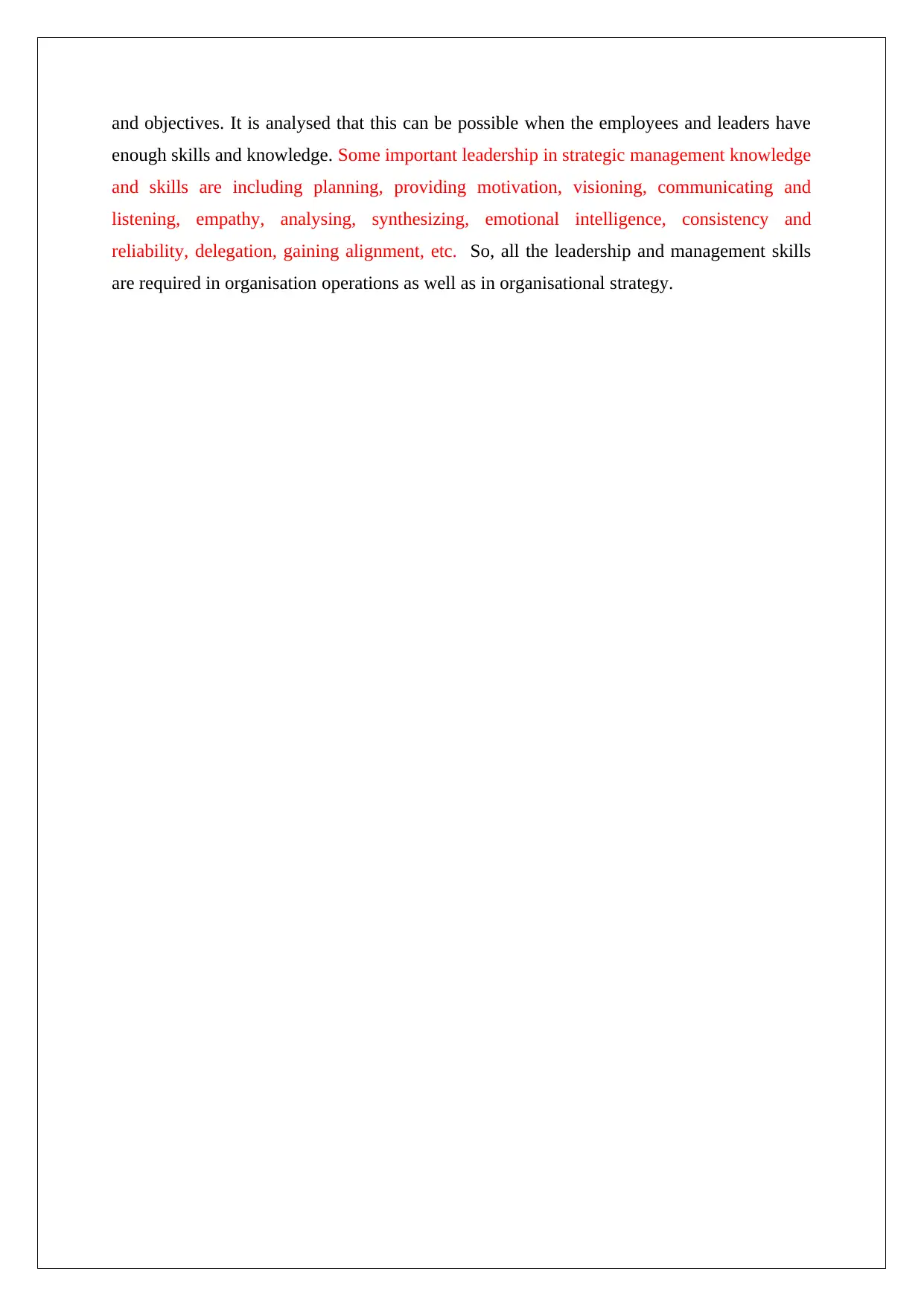
and objectives. It is analysed that this can be possible when the employees and leaders have
enough skills and knowledge. Some important leadership in strategic management knowledge
and skills are including planning, providing motivation, visioning, communicating and
listening, empathy, analysing, synthesizing, emotional intelligence, consistency and
reliability, delegation, gaining alignment, etc. So, all the leadership and management skills
are required in organisation operations as well as in organisational strategy.
enough skills and knowledge. Some important leadership in strategic management knowledge
and skills are including planning, providing motivation, visioning, communicating and
listening, empathy, analysing, synthesizing, emotional intelligence, consistency and
reliability, delegation, gaining alignment, etc. So, all the leadership and management skills
are required in organisation operations as well as in organisational strategy.
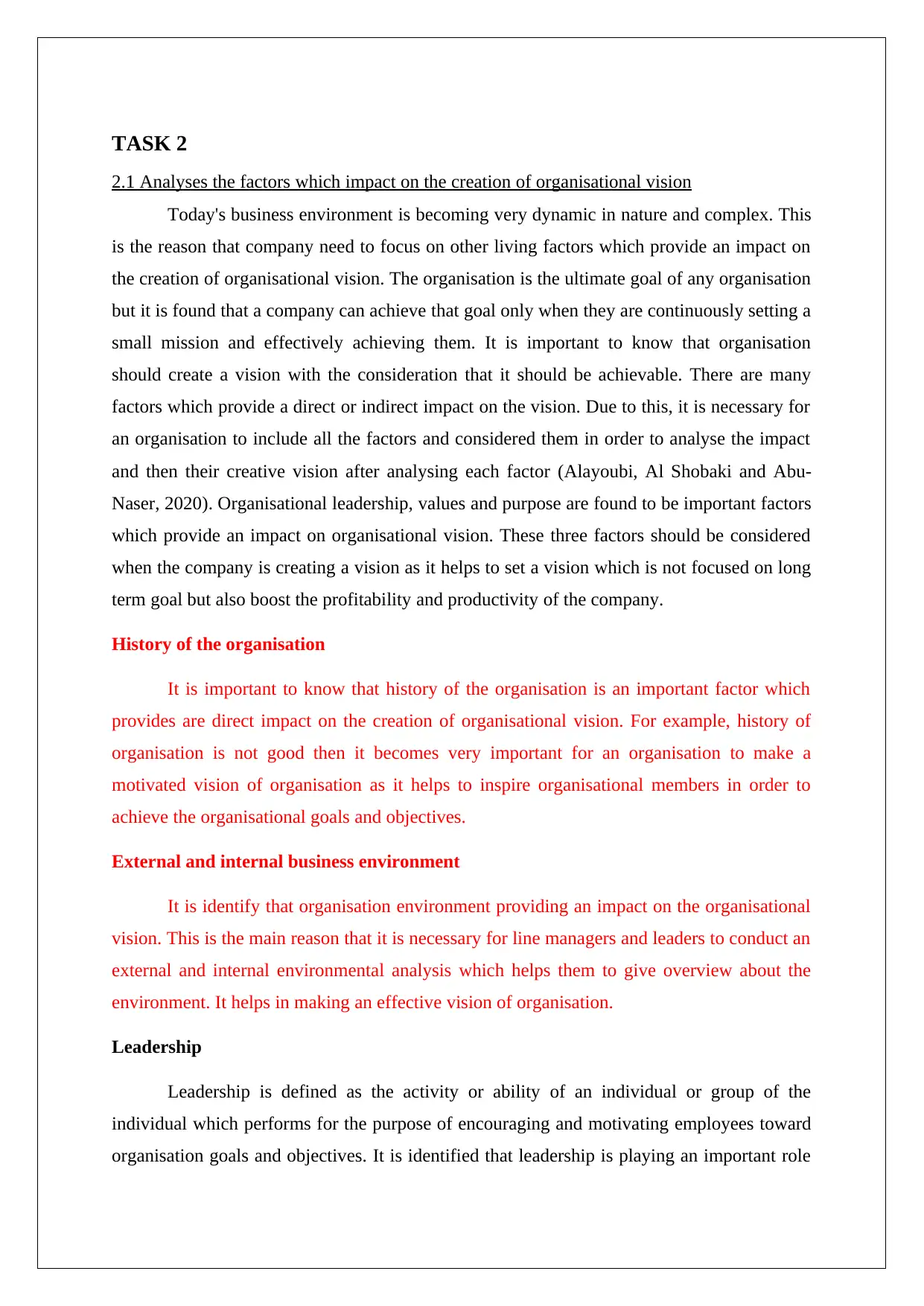
TASK 2
2.1 Analyses the factors which impact on the creation of organisational vision
Today's business environment is becoming very dynamic in nature and complex. This
is the reason that company need to focus on other living factors which provide an impact on
the creation of organisational vision. The organisation is the ultimate goal of any organisation
but it is found that a company can achieve that goal only when they are continuously setting a
small mission and effectively achieving them. It is important to know that organisation
should create a vision with the consideration that it should be achievable. There are many
factors which provide a direct or indirect impact on the vision. Due to this, it is necessary for
an organisation to include all the factors and considered them in order to analyse the impact
and then their creative vision after analysing each factor (Alayoubi, Al Shobaki and Abu-
Naser, 2020). Organisational leadership, values and purpose are found to be important factors
which provide an impact on organisational vision. These three factors should be considered
when the company is creating a vision as it helps to set a vision which is not focused on long
term goal but also boost the profitability and productivity of the company.
History of the organisation
It is important to know that history of the organisation is an important factor which
provides are direct impact on the creation of organisational vision. For example, history of
organisation is not good then it becomes very important for an organisation to make a
motivated vision of organisation as it helps to inspire organisational members in order to
achieve the organisational goals and objectives.
External and internal business environment
It is identify that organisation environment providing an impact on the organisational
vision. This is the main reason that it is necessary for line managers and leaders to conduct an
external and internal environmental analysis which helps them to give overview about the
environment. It helps in making an effective vision of organisation.
Leadership
Leadership is defined as the activity or ability of an individual or group of the
individual which performs for the purpose of encouraging and motivating employees toward
organisation goals and objectives. It is identified that leadership is playing an important role
2.1 Analyses the factors which impact on the creation of organisational vision
Today's business environment is becoming very dynamic in nature and complex. This
is the reason that company need to focus on other living factors which provide an impact on
the creation of organisational vision. The organisation is the ultimate goal of any organisation
but it is found that a company can achieve that goal only when they are continuously setting a
small mission and effectively achieving them. It is important to know that organisation
should create a vision with the consideration that it should be achievable. There are many
factors which provide a direct or indirect impact on the vision. Due to this, it is necessary for
an organisation to include all the factors and considered them in order to analyse the impact
and then their creative vision after analysing each factor (Alayoubi, Al Shobaki and Abu-
Naser, 2020). Organisational leadership, values and purpose are found to be important factors
which provide an impact on organisational vision. These three factors should be considered
when the company is creating a vision as it helps to set a vision which is not focused on long
term goal but also boost the profitability and productivity of the company.
History of the organisation
It is important to know that history of the organisation is an important factor which
provides are direct impact on the creation of organisational vision. For example, history of
organisation is not good then it becomes very important for an organisation to make a
motivated vision of organisation as it helps to inspire organisational members in order to
achieve the organisational goals and objectives.
External and internal business environment
It is identify that organisation environment providing an impact on the organisational
vision. This is the main reason that it is necessary for line managers and leaders to conduct an
external and internal environmental analysis which helps them to give overview about the
environment. It helps in making an effective vision of organisation.
Leadership
Leadership is defined as the activity or ability of an individual or group of the
individual which performs for the purpose of encouraging and motivating employees toward
organisation goals and objectives. It is identified that leadership is playing an important role
⊘ This is a preview!⊘
Do you want full access?
Subscribe today to unlock all pages.

Trusted by 1+ million students worldwide
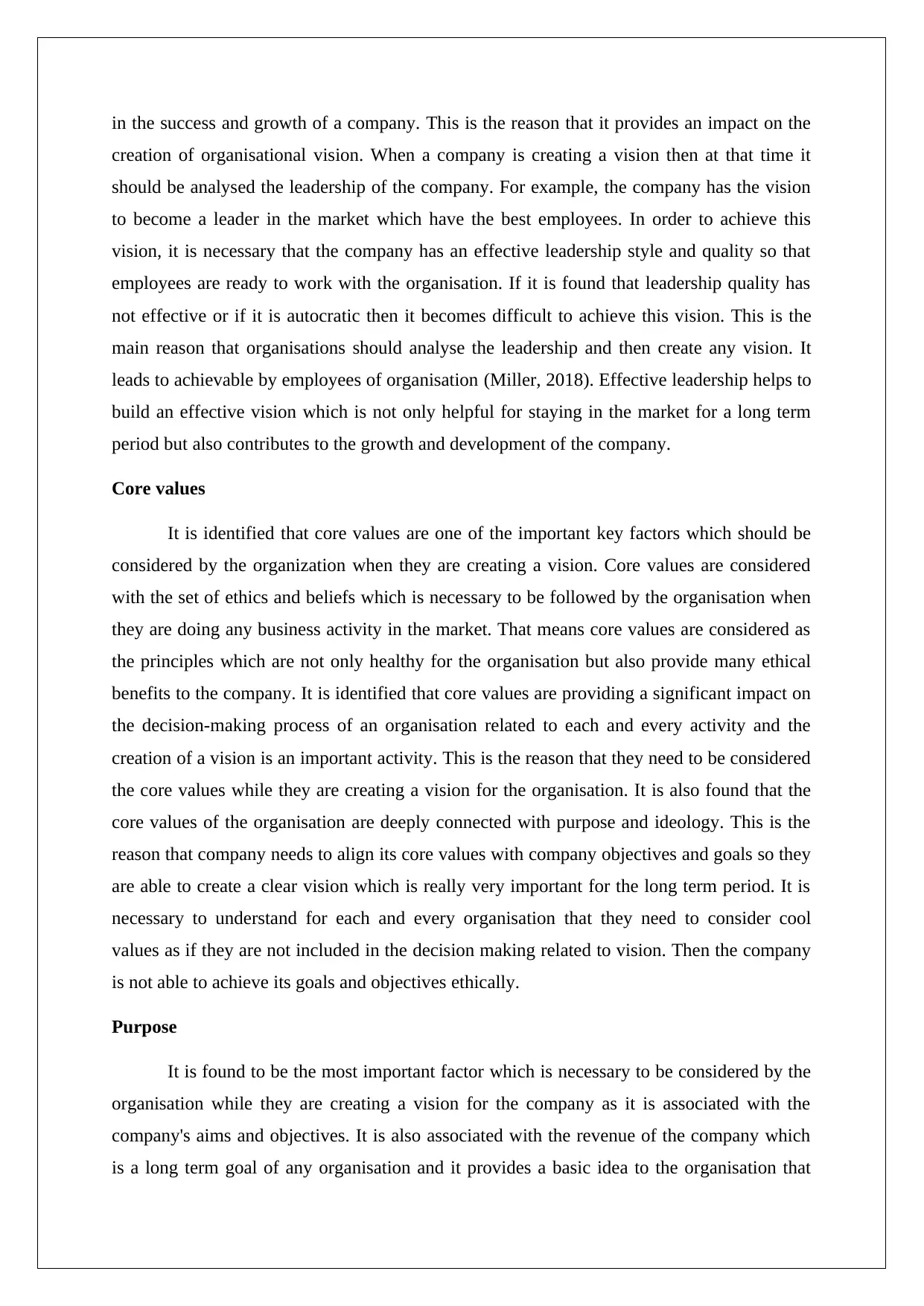
in the success and growth of a company. This is the reason that it provides an impact on the
creation of organisational vision. When a company is creating a vision then at that time it
should be analysed the leadership of the company. For example, the company has the vision
to become a leader in the market which have the best employees. In order to achieve this
vision, it is necessary that the company has an effective leadership style and quality so that
employees are ready to work with the organisation. If it is found that leadership quality has
not effective or if it is autocratic then it becomes difficult to achieve this vision. This is the
main reason that organisations should analyse the leadership and then create any vision. It
leads to achievable by employees of organisation (Miller, 2018). Effective leadership helps to
build an effective vision which is not only helpful for staying in the market for a long term
period but also contributes to the growth and development of the company.
Core values
It is identified that core values are one of the important key factors which should be
considered by the organization when they are creating a vision. Core values are considered
with the set of ethics and beliefs which is necessary to be followed by the organisation when
they are doing any business activity in the market. That means core values are considered as
the principles which are not only healthy for the organisation but also provide many ethical
benefits to the company. It is identified that core values are providing a significant impact on
the decision-making process of an organisation related to each and every activity and the
creation of a vision is an important activity. This is the reason that they need to be considered
the core values while they are creating a vision for the organisation. It is also found that the
core values of the organisation are deeply connected with purpose and ideology. This is the
reason that company needs to align its core values with company objectives and goals so they
are able to create a clear vision which is really very important for the long term period. It is
necessary to understand for each and every organisation that they need to consider cool
values as if they are not included in the decision making related to vision. Then the company
is not able to achieve its goals and objectives ethically.
Purpose
It is found to be the most important factor which is necessary to be considered by the
organisation while they are creating a vision for the company as it is associated with the
company's aims and objectives. It is also associated with the revenue of the company which
is a long term goal of any organisation and it provides a basic idea to the organisation that
creation of organisational vision. When a company is creating a vision then at that time it
should be analysed the leadership of the company. For example, the company has the vision
to become a leader in the market which have the best employees. In order to achieve this
vision, it is necessary that the company has an effective leadership style and quality so that
employees are ready to work with the organisation. If it is found that leadership quality has
not effective or if it is autocratic then it becomes difficult to achieve this vision. This is the
main reason that organisations should analyse the leadership and then create any vision. It
leads to achievable by employees of organisation (Miller, 2018). Effective leadership helps to
build an effective vision which is not only helpful for staying in the market for a long term
period but also contributes to the growth and development of the company.
Core values
It is identified that core values are one of the important key factors which should be
considered by the organization when they are creating a vision. Core values are considered
with the set of ethics and beliefs which is necessary to be followed by the organisation when
they are doing any business activity in the market. That means core values are considered as
the principles which are not only healthy for the organisation but also provide many ethical
benefits to the company. It is identified that core values are providing a significant impact on
the decision-making process of an organisation related to each and every activity and the
creation of a vision is an important activity. This is the reason that they need to be considered
the core values while they are creating a vision for the organisation. It is also found that the
core values of the organisation are deeply connected with purpose and ideology. This is the
reason that company needs to align its core values with company objectives and goals so they
are able to create a clear vision which is really very important for the long term period. It is
necessary to understand for each and every organisation that they need to consider cool
values as if they are not included in the decision making related to vision. Then the company
is not able to achieve its goals and objectives ethically.
Purpose
It is found to be the most important factor which is necessary to be considered by the
organisation while they are creating a vision for the company as it is associated with the
company's aims and objectives. It is also associated with the revenue of the company which
is a long term goal of any organisation and it provides a basic idea to the organisation that
Paraphrase This Document
Need a fresh take? Get an instant paraphrase of this document with our AI Paraphraser
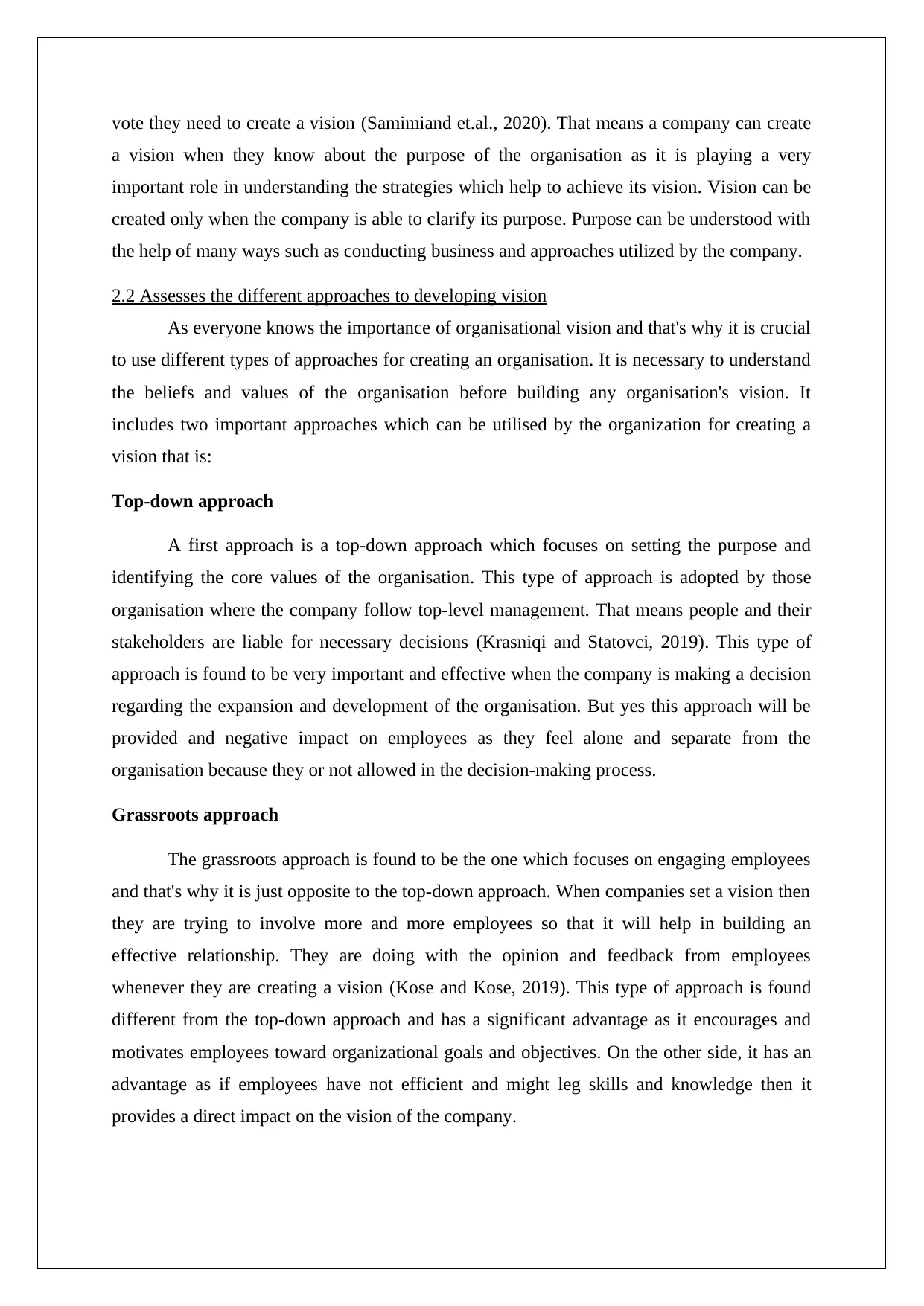
vote they need to create a vision (Samimiand et.al., 2020). That means a company can create
a vision when they know about the purpose of the organisation as it is playing a very
important role in understanding the strategies which help to achieve its vision. Vision can be
created only when the company is able to clarify its purpose. Purpose can be understood with
the help of many ways such as conducting business and approaches utilized by the company.
2.2 Assesses the different approaches to developing vision
As everyone knows the importance of organisational vision and that's why it is crucial
to use different types of approaches for creating an organisation. It is necessary to understand
the beliefs and values of the organisation before building any organisation's vision. It
includes two important approaches which can be utilised by the organization for creating a
vision that is:
Top-down approach
A first approach is a top-down approach which focuses on setting the purpose and
identifying the core values of the organisation. This type of approach is adopted by those
organisation where the company follow top-level management. That means people and their
stakeholders are liable for necessary decisions (Krasniqi and Statovci, 2019). This type of
approach is found to be very important and effective when the company is making a decision
regarding the expansion and development of the organisation. But yes this approach will be
provided and negative impact on employees as they feel alone and separate from the
organisation because they or not allowed in the decision-making process.
Grassroots approach
The grassroots approach is found to be the one which focuses on engaging employees
and that's why it is just opposite to the top-down approach. When companies set a vision then
they are trying to involve more and more employees so that it will help in building an
effective relationship. They are doing with the opinion and feedback from employees
whenever they are creating a vision (Kose and Kose, 2019). This type of approach is found
different from the top-down approach and has a significant advantage as it encourages and
motivates employees toward organizational goals and objectives. On the other side, it has an
advantage as if employees have not efficient and might leg skills and knowledge then it
provides a direct impact on the vision of the company.
a vision when they know about the purpose of the organisation as it is playing a very
important role in understanding the strategies which help to achieve its vision. Vision can be
created only when the company is able to clarify its purpose. Purpose can be understood with
the help of many ways such as conducting business and approaches utilized by the company.
2.2 Assesses the different approaches to developing vision
As everyone knows the importance of organisational vision and that's why it is crucial
to use different types of approaches for creating an organisation. It is necessary to understand
the beliefs and values of the organisation before building any organisation's vision. It
includes two important approaches which can be utilised by the organization for creating a
vision that is:
Top-down approach
A first approach is a top-down approach which focuses on setting the purpose and
identifying the core values of the organisation. This type of approach is adopted by those
organisation where the company follow top-level management. That means people and their
stakeholders are liable for necessary decisions (Krasniqi and Statovci, 2019). This type of
approach is found to be very important and effective when the company is making a decision
regarding the expansion and development of the organisation. But yes this approach will be
provided and negative impact on employees as they feel alone and separate from the
organisation because they or not allowed in the decision-making process.
Grassroots approach
The grassroots approach is found to be the one which focuses on engaging employees
and that's why it is just opposite to the top-down approach. When companies set a vision then
they are trying to involve more and more employees so that it will help in building an
effective relationship. They are doing with the opinion and feedback from employees
whenever they are creating a vision (Kose and Kose, 2019). This type of approach is found
different from the top-down approach and has a significant advantage as it encourages and
motivates employees toward organizational goals and objectives. On the other side, it has an
advantage as if employees have not efficient and might leg skills and knowledge then it
provides a direct impact on the vision of the company.
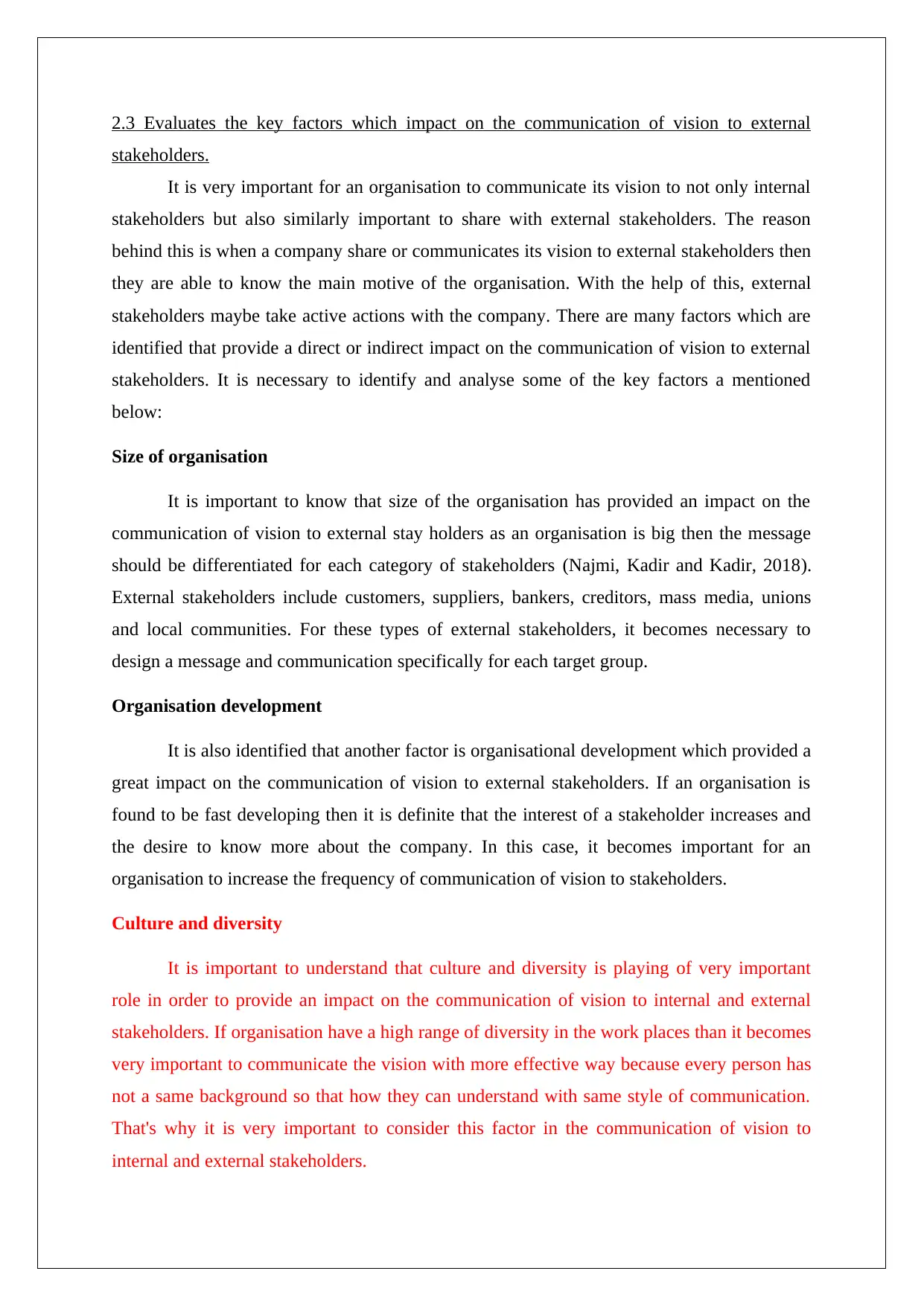
2.3 Evaluates the key factors which impact on the communication of vision to external
stakeholders.
It is very important for an organisation to communicate its vision to not only internal
stakeholders but also similarly important to share with external stakeholders. The reason
behind this is when a company share or communicates its vision to external stakeholders then
they are able to know the main motive of the organisation. With the help of this, external
stakeholders maybe take active actions with the company. There are many factors which are
identified that provide a direct or indirect impact on the communication of vision to external
stakeholders. It is necessary to identify and analyse some of the key factors a mentioned
below:
Size of organisation
It is important to know that size of the organisation has provided an impact on the
communication of vision to external stay holders as an organisation is big then the message
should be differentiated for each category of stakeholders (Najmi, Kadir and Kadir, 2018).
External stakeholders include customers, suppliers, bankers, creditors, mass media, unions
and local communities. For these types of external stakeholders, it becomes necessary to
design a message and communication specifically for each target group.
Organisation development
It is also identified that another factor is organisational development which provided a
great impact on the communication of vision to external stakeholders. If an organisation is
found to be fast developing then it is definite that the interest of a stakeholder increases and
the desire to know more about the company. In this case, it becomes important for an
organisation to increase the frequency of communication of vision to stakeholders.
Culture and diversity
It is important to understand that culture and diversity is playing of very important
role in order to provide an impact on the communication of vision to internal and external
stakeholders. If organisation have a high range of diversity in the work places than it becomes
very important to communicate the vision with more effective way because every person has
not a same background so that how they can understand with same style of communication.
That's why it is very important to consider this factor in the communication of vision to
internal and external stakeholders.
stakeholders.
It is very important for an organisation to communicate its vision to not only internal
stakeholders but also similarly important to share with external stakeholders. The reason
behind this is when a company share or communicates its vision to external stakeholders then
they are able to know the main motive of the organisation. With the help of this, external
stakeholders maybe take active actions with the company. There are many factors which are
identified that provide a direct or indirect impact on the communication of vision to external
stakeholders. It is necessary to identify and analyse some of the key factors a mentioned
below:
Size of organisation
It is important to know that size of the organisation has provided an impact on the
communication of vision to external stay holders as an organisation is big then the message
should be differentiated for each category of stakeholders (Najmi, Kadir and Kadir, 2018).
External stakeholders include customers, suppliers, bankers, creditors, mass media, unions
and local communities. For these types of external stakeholders, it becomes necessary to
design a message and communication specifically for each target group.
Organisation development
It is also identified that another factor is organisational development which provided a
great impact on the communication of vision to external stakeholders. If an organisation is
found to be fast developing then it is definite that the interest of a stakeholder increases and
the desire to know more about the company. In this case, it becomes important for an
organisation to increase the frequency of communication of vision to stakeholders.
Culture and diversity
It is important to understand that culture and diversity is playing of very important
role in order to provide an impact on the communication of vision to internal and external
stakeholders. If organisation have a high range of diversity in the work places than it becomes
very important to communicate the vision with more effective way because every person has
not a same background so that how they can understand with same style of communication.
That's why it is very important to consider this factor in the communication of vision to
internal and external stakeholders.
⊘ This is a preview!⊘
Do you want full access?
Subscribe today to unlock all pages.

Trusted by 1+ million students worldwide
1 out of 28
Related Documents
Your All-in-One AI-Powered Toolkit for Academic Success.
+13062052269
info@desklib.com
Available 24*7 on WhatsApp / Email
![[object Object]](/_next/static/media/star-bottom.7253800d.svg)
Unlock your academic potential
Copyright © 2020–2025 A2Z Services. All Rights Reserved. Developed and managed by ZUCOL.





